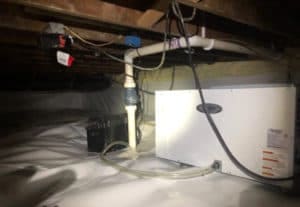How to Fix a Sagging Floor

Originally published 8/27/18, updated 11/12/20
Are sagging floors tripping you up? Is your furniture slowly sliding out of place? Does your floor feel bouncy or spongy in certain places? These are more than just a nuisance! A sagging floor is usually a sign that something is very wrong with your home’s structural wooden framework, if you have a basement or crawl space.
Founded in 1996, Acculevel has been repairing foundations and waterproofing crawl spaces for decades. We know that if a sagging floor is left unrepaired, it will result in major structural damage to your home. We believe every homeowner deserves a safe and healthy home, and we want to help you protect your greatest investment.
Most sagging floors are caused by moisture. There are other issues that can contribute to the problem, but moisture is almost always the primary culprit. We’ll explain why moisture is the biggest threat, review the repair methods needed, and provide additional resources for you to use while hiring the best contractor to fix your sagging floor.
How Can Moisture Damage My Floor?
Unlike basement floors or slab foundations, which normally are poured concrete, most crawl spaces are built on bare ground. As the weather changes humidity levels and soil saturation, moisture evaporates from the earth. This moisture is in the air under your home, which is also where the wooden components of your home’s flooring structure are.
Wood is porous, and becomes damp with the evaporation. How severe this dampness is, depends on two factors.
- Positive effect: if you have a vapor barrier installed. A vapor barrier is simply a piece of plastic liner spread out over the ground in your crawl space. It won’t block out all of the moisture, but it does help.
- Negative effect: if you have fiberglass insulation installed. Many builders still insert fiberglass insulation into the flooring structure between joists. This type of insulation acts like a sponge and absorbs moisture. A damp sponge held against wooden supports will actively contribute to decay.
When the wooden structure under your flooring is damp, it creates an ideal environment for damaging insects like termites and health threats like mold.
 This photo was taken by an Acculevel project manager during a routine free estimate. The crawl space has no vapor barrier, and the joists and beam are decaying and covered in mold.
This photo was taken by an Acculevel project manager during a routine free estimate. The crawl space has no vapor barrier, and the joists and beam are decaying and covered in mold.
How Do I Repair the Damage to My Floors?
The best method for repairing a sagging floor begins with clean-up. If you enjoy DIY projects, this is one part you can do yourself. The fiberglass insulation needs to be removed; you’ll find some of it will already be falling out of place. Insulation gets heavier when it’s wet, and that added weight pulls it down.
You can also check your vapor barrier, and inspect it for holes, gaps, and other damages. Most vapor barriers are only good for 5-10 years. You can replace it yourself- but you should wait until after the flooring components are repaired.
Repairing damaged flooring structure is not a good DIY project. You should find a good quality contractor who can evaluate your home, the structural issues, and properly diagnose which wooden components are faulty. This article breaks down the individual components, the repair methods, and pricing.
How Do I Prevent My Floors from Sagging?
Once you’ve had the wooden structural components repaired – or if your flooring is currently in good condition- you should address the underlying cause of the problem. You’ll need to eliminate the moisture in your crawl space. Depending on the condition of your home, the steps can vary, but here are the basics:
- If you haven’t removed the fiberglass insulation yet, do so now. We recommend that you replace it with spray foam insulation, which repels moisture.
- Install water drainage, if rain causes puddles or flooding in your crawl space.
- Install and replace your vapor barrier every 5 years, or invest in crawl space encapsulation.
 This photo was taken by an Acculevel crew member after crawl space encapsulation.
This photo was taken by an Acculevel crew member after crawl space encapsulation.
What’s Next?
Once you feel confident you’ve researched the options, and have a good idea of the approximate costs, it’s time to hire a contractor. Haven’t done this before? (Or maybe you have experienced less than stellar customer service.) Please use our guide on Questions to Ask a Contractor. The blog article gives our answers to these questions, and includes a link to a free blank questionnaire you can use to protect yourself.
If you live in Indiana or the surrounding states, contact Acculevel. We specialize in crawl space repairs and waterproofing, and provide free estimates to all our customers. Contact our office, and one of our friendly staff will schedule an appointment for you with an experienced project manager. They will evaluate your house and its symptoms, then recommend the best course of action for you, to keep your home strong and healthy for years to come.
Acculevel’s goal is to do the best and most thorough repair possible, to protect and maintain your home. We know that allowing our employees into your home demonstrates trust, and we intend to repay that trust with the absolute best in customer service. Acculevel is accredited by the BBB, has an A+ rating, and average 5 stars on customer reviews.